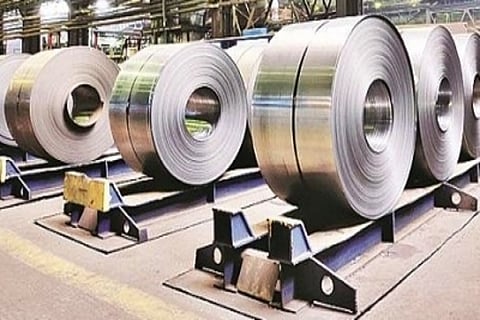

New Delhi
The import tide of stainless steel from China and Indonesia is fast turning into a deluge destroying many companies on its way, and threatening the very existence of the small, medium and micro industries in India. After all, the first half of 2021-22 witnessed a staggering 185% increase in import volumes of stainless steel flat products compared to the average monthly imports in the last fiscal, fuelled mostly by surge in Chinese and Indonesian imports.
The two countries China and Indonesia, which increased their exports by 300 per cent and 339 per cent, respectively, in the first half of this fiscal compared to the average monthly imports of the last fiscal, now have a share of 79 per cent of the total stainless steel flat product imports in the first half of FY22. It is a significant jump compared to the 44 per cent share in FY21. The average per month imports has jumped from 34,105 tonnes per month in FY21 to 63,154 tonnes per month this current fiscal--FY 22.
Indonesia's imports share, which was virtually non-existent in 2016-17, has climbed to 23 per cent in the first half of this fiscal, with its average monthly exports increasing from 4,355 tonnes/month in the last fiscal to 14,766 tonnes/month in the first half of this fiscal. China's average monthly exports too has jumped from 10,697 tonnes/month in the last fiscal to 35,269 tonnes/month in the first half of this fiscal.
The surge in imports was the result of the Finance Ministry's decision of September 30, 2021 to revoke the imposition of CVD on China (September 2017) and end provisional duties on Indonesia (October 2020), which was based on the recommendations of the Director-General of Trade Remedies (DGTR), after a detailed investigation. The investigation had revealed that the two countries were resorting to non-WTO compliant subsidies to boost their exports to India and causing injury to Indian manufacturers.
In fact, the DGTR and their global counterparts had conclusively proved in its final finding that both these countries provide non-WTO compliant subsidies to the tune of 20 per cent to 30 per cent to their stainless steel manufacturers. And, these subsidies have created an imbalance in the Indian and international markets, reduced the competitiveness of Indian products in the domestic industry, causing material injury and persistent financial stress for home-grown businesses. It has forced the domestic industry to seek redressal from the surge in imports.
In fact, in India a disaggregated study of imported products in the first half of the current fiscal also reveals how excessive dumping has taken place in a particular J3 grade of stainless steel in the country. Imports of J3, a subsidised and dumped 200 series grade of stainless steel, with about 1 per cent nickel and 13 per cent chromium from China, has jumped from an average of 1,779 tonnes/month in 2019 to an average of 4,425 tonnes/month in 20-21 (249 per cent increase) and to average 25,346 tonnes to in just six months of 2021-22 (1,424 per cent) increase compared to the same period last year.
The share of this grade in total imports from China increased 23 per cent in 2019-20 to 72 per cent in 2021-22. Much of this import is even below the scrap prices and it hurts the MSME sector, the hardest. Such dumping also means major losses in terms of national exchequer through tax evasion and revenue losses.
This onslaught of Chinese exports to India has decimated the micro, small and medium enterprises (MSME), which had to bear the brunt of the impact. In fact, the imposition of provisional CVD on Indonesia in October 2020 and CVD on China in place from September 2017, had provided a "level-playing field" to these players, which got a much-needed relief from the dumped subsidised imports. The MSME, an industry having the capacity to produce about 1.2 lakh tonnes of hot and cold-rolled flat products, was able to operate at 90 per cent plus capacity utilization between October 2020 to February 2021.
However, the MSME sector suddenly finds itself grasping for breath to survive after the announcements of the 2021-22 Budget. Small-scale stainless- steel rollers and re-rollers, who make ingots from recyclable scrap as the first step in stainless- steel product manufacturing, and then produce hot and cold rolled materials for the all-India market, find themselves swamped by a massive and subsidised surge of imports from China and Indonesia.
Today, more than 80 induction furnaces and 500 patti/patta units, which provides primary raw materials for various downstream industries, are in dire straits. These downstream industries manufacture a variety of stainless steel household goods such as kitchenware, tableware, cooking range, sanitary items, cutlery pots, etc.
Prakash Jain, President, All India Stainless Steel Cold Roller Association, says: "The smaller Indian stainless steel players finds it virtually impossible to compete with the state-subsidised Chinese players, who get an 18 per cent incentive to export, under invoice their products by changing the label of the products to avoid paying duties and sell it at Rs 15 to Rs 17 per tonne cheaper in the Indian market."
According to Jain, Gujarat has 70 rolling mills, each employing around 300 people and 50 induction furnaces, which makes ingots, the raw material for rolling mills and employs 500 each.
Not only will many of these jobs be lost resulting in massive unemployment but force many manufacturers to turn traders unless the CVD is imposed on imports from China and Indonesia.
Visit news.dtnext.in to explore our interactive epaper!
Download the DT Next app for more exciting features!
Click here for iOS
Click here for Android